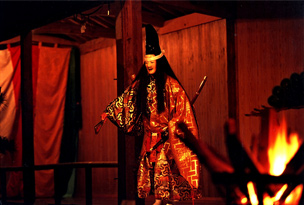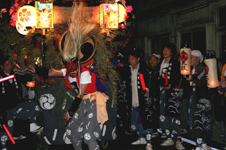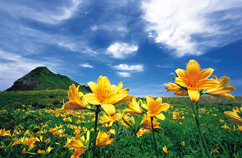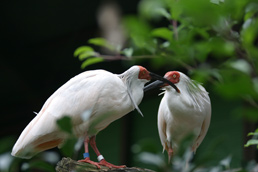Performing Arts
 Sado Island abounds with folk tales including those well known to the whole country, mysterious legends, curious folk arts and folk songs rich in atmosphere. These folk arts and folk songs have been handed down to younger generations as indispensable parts of events such as festivals held all the year round. Even now, these folk arts and folk songs persist in the life of Sado islanders.
Sado Island abounds with folk tales including those well known to the whole country, mysterious legends, curious folk arts and folk songs rich in atmosphere. These folk arts and folk songs have been handed down to younger generations as indispensable parts of events such as festivals held all the year round. Even now, these folk arts and folk songs persist in the life of Sado islanders.
The Noh play, which is renowned as one of the traditional performances of Japan, has come to be widely performed on Sado, because Zeami, who had brought Noh to completion, was exiled to Sado, and because Okubo Iwamimori Nagayasu, the first magistrate of Sado, was formerly a Noh player. There are actually as many as 32 Noh stages on Sado, which account for one third of all Noh stages in the whole of Japan. Every year from April till October the islanders perform Takigi-noh (torchlight Noh performance) on the Noh stage built adjacent to the shrine. The simplicity and mightiness of Takigi-noh have continued to captivate the hearts of the spectators from in and out of Sado.
Oni-daiko is one of the performing arts loved by the islanders. This is a folk art which has been handed down and rooted in the villages of Sado for more than 500 years as a dance designed to ward off the devils and pray for a bountiful harvest. Oni-daiko is performed in more than one hundred villages throughout the island. On the day of the festival, Oni-daiko performers go around from door to door in each village, dancing valiantly to the rhythm of the drum. The way they dance is really superb!
Sado Okesa (Sado's folk song and dance) is believed to have been brought by sailors who called at ports on Sado in the days of  Kitamaebune, the merchant ships that sailed through the Sea of Japan between Hokkaido and Osaka from the Edo era to the Meiji era. It is believed that Haiya-bushi, a folk song of Ushibuka in the Kyushu district has developed into Sado Okesa in its original way. When you are about to land on the island after taking a ferry from Niigata to Sado, please strain your ears. The sound of Sado Okesa you hear on the ship will make your arrival full of deep emotion.
Kitamaebune, the merchant ships that sailed through the Sea of Japan between Hokkaido and Osaka from the Edo era to the Meiji era. It is believed that Haiya-bushi, a folk song of Ushibuka in the Kyushu district has developed into Sado Okesa in its original way. When you are about to land on the island after taking a ferry from Niigata to Sado, please strain your ears. The sound of Sado Okesa you hear on the ship will make your arrival full of deep emotion.
Among other entertainments are Bunya-ningyo (Sado's traditional puppet play), Hanakasa Dance, Harigoma, Noroma Dolls, Sekkyo Dolls, Mano Ondo (folk dance), Kojishi Dance, Tsuburosashi, many of which are performances for praying for a good harvest, the well-being of one's family and the prosperity of one's offsprings. Please do come and experience these many performing arts handed down from generation to generation on this isolated island.
Trivial information about Sado
Besides those above-mentioned entertainments, there are several other performances that you might want to see at least once, such as "Chitochinton,"an eccentric traditional performance which is occasionally introduced on TV in Japan. It might be an interesting idea to ask local people, "What kind of traditional entertainment is popular in this vicinity?" at each place you visit on Sado.
Nature
 Biologically speaking, Sado is an island where a large variety of plants coexist, because its center is divided at latitude 38 degrees north, which forms the border line between the range of plants of northern extraction and that of vegitation of sourthern origin. In addition, the Tsushima Current (a warm current off Sado Island) makes the island warmer in winter and cooler in summer than the mainland part of Niigata Prefecture. This is why plants of the temperate zone such as loquats and Japanese beeches can be seen in the warm Kosado area, while in the Osado area plants of the frigid zone such as Japanese red pines and oaks can be seen. Even apples which are the specialty of Aomori, the snow country in the northernmost part of Honshu, and tangerine oranges, the specialty of Wakayama, the warm prefecture far southwest of Sado, can be produced on Sado Island.
Biologically speaking, Sado is an island where a large variety of plants coexist, because its center is divided at latitude 38 degrees north, which forms the border line between the range of plants of northern extraction and that of vegitation of sourthern origin. In addition, the Tsushima Current (a warm current off Sado Island) makes the island warmer in winter and cooler in summer than the mainland part of Niigata Prefecture. This is why plants of the temperate zone such as loquats and Japanese beeches can be seen in the warm Kosado area, while in the Osado area plants of the frigid zone such as Japanese red pines and oaks can be seen. Even apples which are the specialty of Aomori, the snow country in the northernmost part of Honshu, and tangerine oranges, the specialty of Wakayama, the warm prefecture far southwest of Sado, can be produced on Sado Island.
Because Sado is an island surrounded by the waters and so humidity is kept high, the number of the species of plants that have been preserved from olden times is said to surpass 1,700.
In spring, the season of wild plants starts around March before the cherry blossoms bloom, and such wid flowers as Amur adonises, mealy primroses, Japanese wood poppies, dogtooth violets, skunk cabbages, alpine roses and Japanese azelias run riot one after another. In June in the northernmost part of Sado called Onogame, Tobishima-kanzo (licorices, large flowers of the lily family) come out and turn the whole place into an ogange-colored carpet. The Tobishima-kanzo is a special kind of licorice that can be found only on the coast of Tobishima and Sakata, Yamagata Prefecture and on the coasts of Sado where the seasonal wind blows from the northwest.
In autumn red and yellow foliage is beautiful, and Osado Skyline, the road that runs through the ridges of the Osado Mountain Range, makes one of the most popular sightseeing routes. From winter through spring the red flowers of camellias bloom vividly inside the hedges of houses and in the hills and mountains. Along with Nagasaki, Sado used to be the place where camellia oil was produced, and even now many camellia trees grow naturally all over Sado Island.
 Sado City is also famous as the habitat of the precious natural monument toki (Japanese crested ibis). The islanders succeeded in breeding toki artificially, although toki had been on the verge of extinction, and in September, 2008, a tentative release of the birds was carried out as the first step toward toki's return to nature. As of 2010, nearly 150 crested ibises are bred on Sado Island. As one of the ways of putting the habitat of toki in good conditon, a biotope is being built by the local people, and other attempts are being made to restore the natural environment.
Sado City is also famous as the habitat of the precious natural monument toki (Japanese crested ibis). The islanders succeeded in breeding toki artificially, although toki had been on the verge of extinction, and in September, 2008, a tentative release of the birds was carried out as the first step toward toki's return to nature. As of 2010, nearly 150 crested ibises are bred on Sado Island. As one of the ways of putting the habitat of toki in good conditon, a biotope is being built by the local people, and other attempts are being made to restore the natural environment.
For lovers of nature Sado can be referred to as a "dream island."
Trivial information about Sado
*As many as 1,700 species of vegetation can be found on Sado island. Hokkaido is said to have 1,800 species (except for fern), while even Yakushima, the world heritage in Kagoshima Prefecture which is regarded as the starting point of Japan's nature, has not more than 1,370 species. All this shows how abundant Sado's vegetation is.
*The natural ceder tree which is said to be more than 500 years old was discovered by photographer Mr. Takashi Amano, and at the G8 Hokkaido Toyako Summit held in 2008, the theme of which was "environment," a large-sized photograph of the ceder tree was displayed in the place for the dinner and luncheon parties.
*In the French movie, "OCEANS," whose theme is the sea, Kobudai (bulgyhead wrasse) of Sado appear. In the sea off the village called "Kitakoura" is the only place in the world where the feeding of Kobudai is possible. In the southern part of Sado Island you can find coral reefs. The waters around Sado Island have various faces, and they are also known to provide "hidden" diving spots.